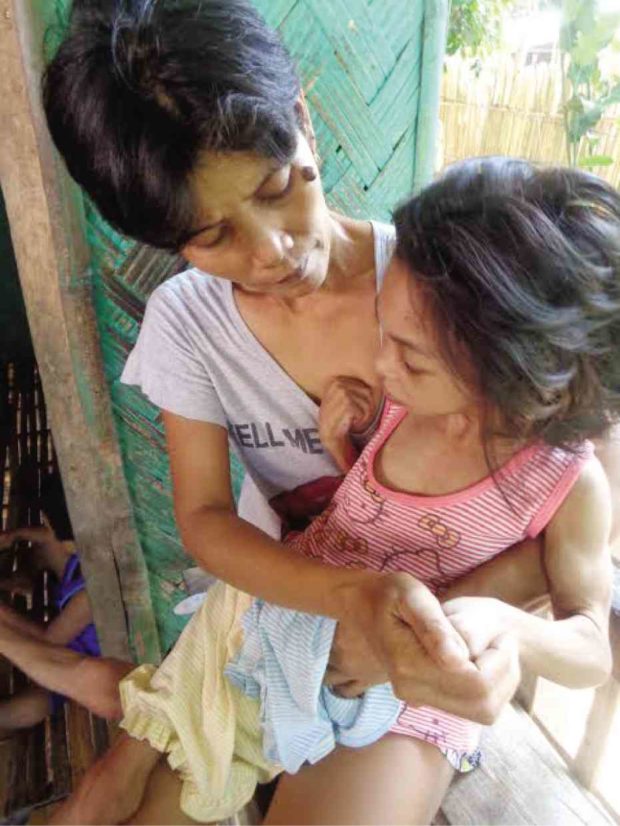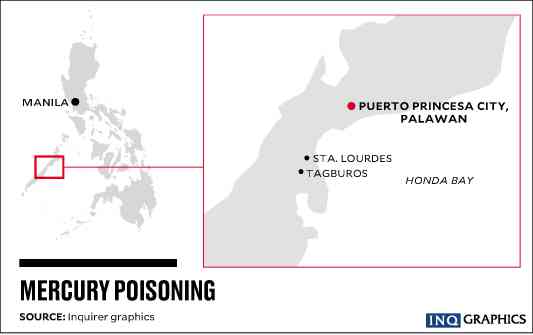Widespread mercury poisoning detected in 2 Palawan villages

Marivic Edradan, 43, shown here with 11-year-old daughter Nikka, says she used to pan for mercury at Tagburos River in Puerto Princesa City. Edradan, whose daughter suffers from suspected cerebral palsy, is among residents of a community in the city where cases of mercury poisoning are widespread. —REDEMPTO ANDA
PUERTO PRINCESA CITY—A recently concluded study by the health and environment departments in a highly populated community near an abandoned mercury mining site on the outskirts of this Palawan capital has recorded widespread cases of mercury poisoning among residents.
This prompted calls for the declaration of a health crisis and the immediate evacuation and relocation of residents in two villages here and mass treatment of victims.
A copy of the report’s summary, obtained by the Inquirer from the city government through a Freedom of Information request, showed that most residents of the villages of Sta. Lourdes and Tagburos, with a combined population of more than 10,000, are suffering from varying degrees of mercury poisoning due to constant exposure to mine tailings and ingestion of marine products contaminated by poisonous mercury ore.
The report was presented to Puerto Princesa City officials two weeks ago by representatives of the Mines and Geosciences Bureau, the Department of Health and the Department of Environment and Natural Resources (DENR) during a closed door meeting.
Local officials have yet to fully disclose the results of the study to the public but are coordinating with the DENR on plans to initially relocate over 80 families living around a 3-hectare lake that used to be an open pit mercury mining area of the now-defunct Palawan Quicksilver Mines Inc. (PQMI).
PQMI, which operated in the area between 1955 and 1976, exported mercury to Japan, records showed.
Relocation
An area where PQMI used to dump mine tailings in Sta. Lourdes is now a busy wharf and hosts several government facilities, including a US-funded maritime enforcement group (PNP-Maritime Special Boat Unit). A tourism-based community built around the popular Honda Bay island-hopping destination, an attraction that draws close to a million visitors every year, thrives in that area.
The report identified the main sources of mercury poisoning in the area as the exposed ores, the 3-ha pit lake and the city’s sanitary landfill, a facility built over a mined out area in the late 1990s, and the Tagburos River, which drains out to Honda Bay.
The study showed that seepage from the landfill was highly contaminated with mercury and could compromise the water tables in the area.
It urged the city government to “relocate residents in contaminated areas who are symptomatic to mercury poisoning due to elevated mercury levels in blood, hair and/or urine.”
The study, with most of the fieldwork conducted from 2015 until last year and involved sampling from residents of Sta. Lourdes and Tagburos, discovered varying degrees of mercury poisoning in majority of residents tested.
It enumerated symptoms of the Minamata disease common among affected residents. These are gingivitis, discoloration of gums, nervousness, numbness, headache, palpitations and difficulty in sleeping, difficulty in concentrating, memory problems and respiratory problems.
Traces of other toxic minerals were also found in their blood samples.
“The primary source of environmental exposure to mercury in the general population is maybe due to the consumption of contaminated fish. High levels of methylmercury in the hair samples indicate that the route of exposure is through ingestion or consumption of fish. Levels of copper and cadmium noted on the residents need further investigation,” it said.
Mayor Luis Marcaida III, through a spokesperson, said the city government would fast track the relocation of residents and undertake a medication program for them.
“We are looking at a potential relocation site already and we are going to do it phase by phase because many residents will be affected,” he said.
